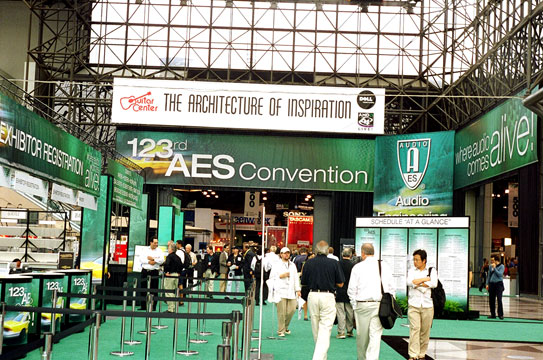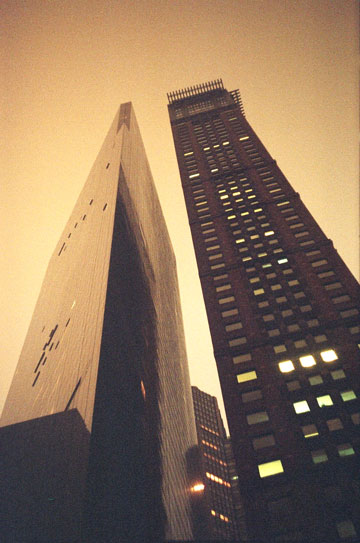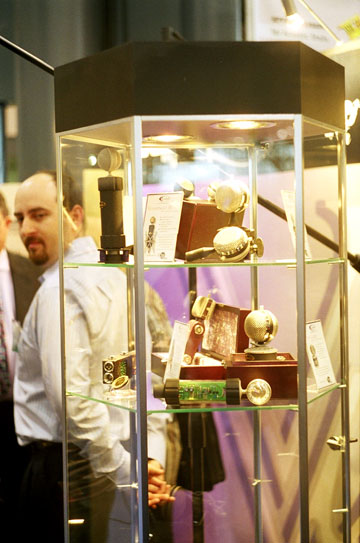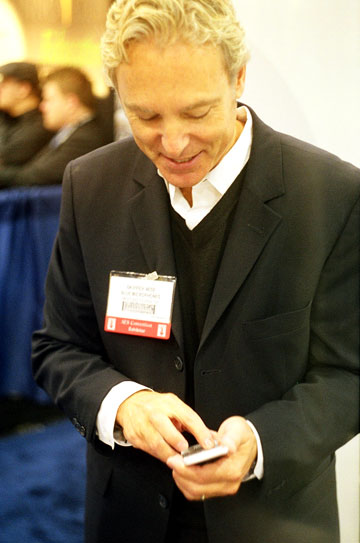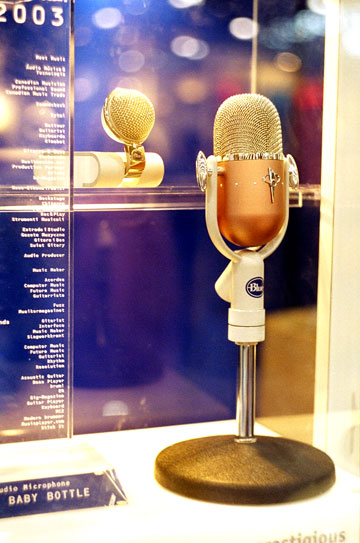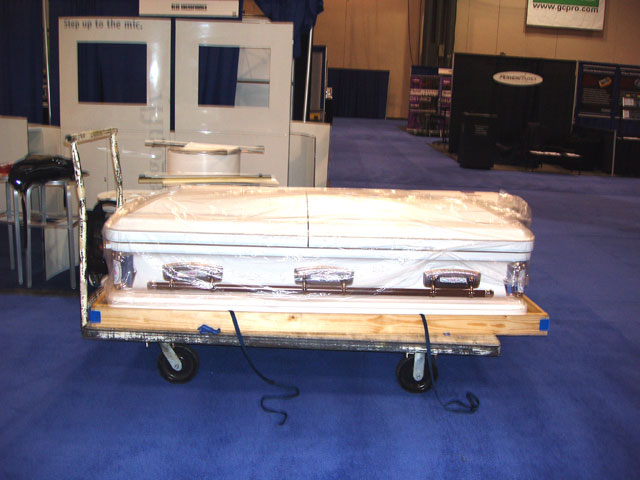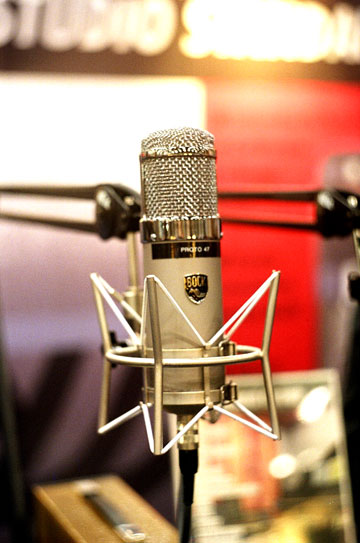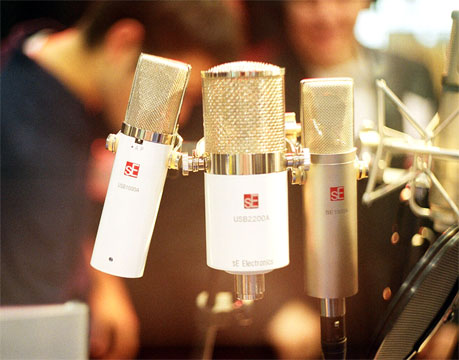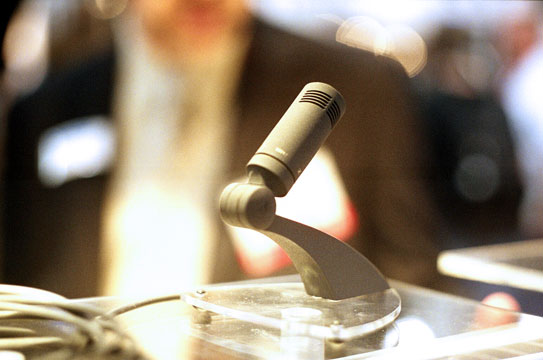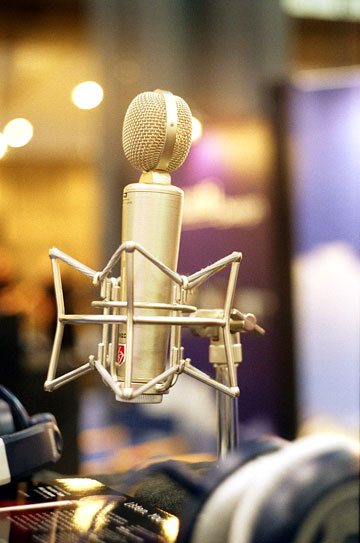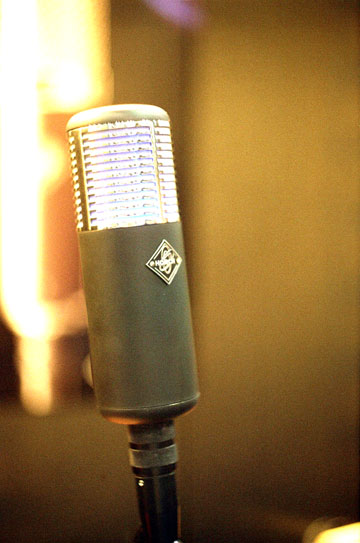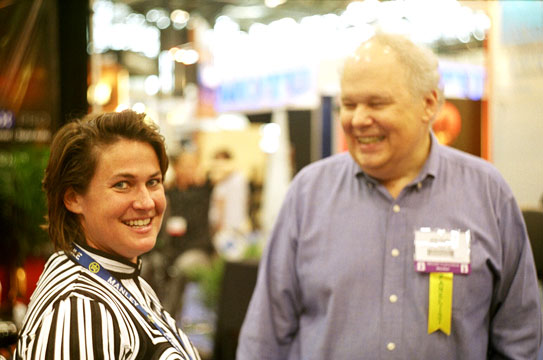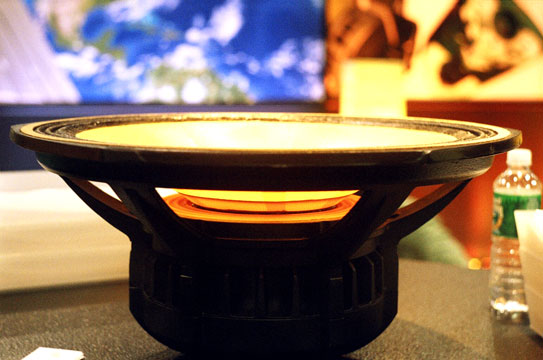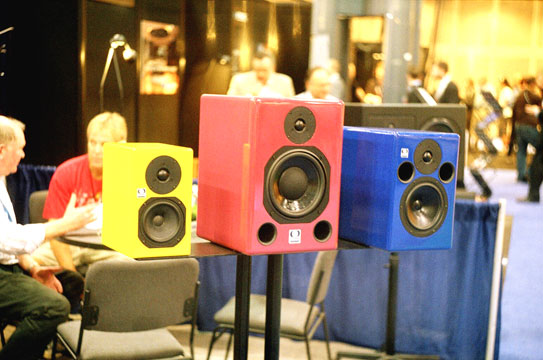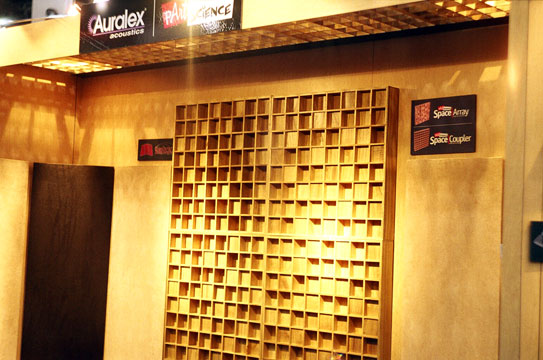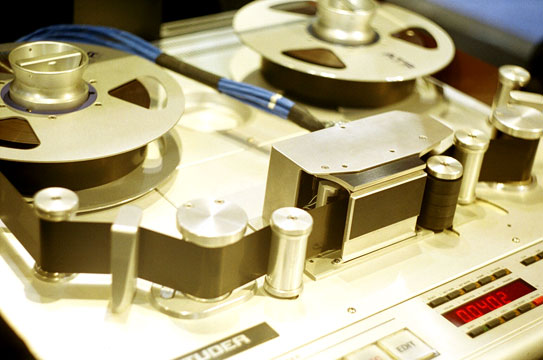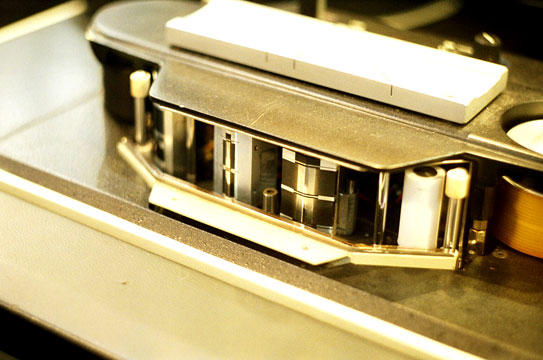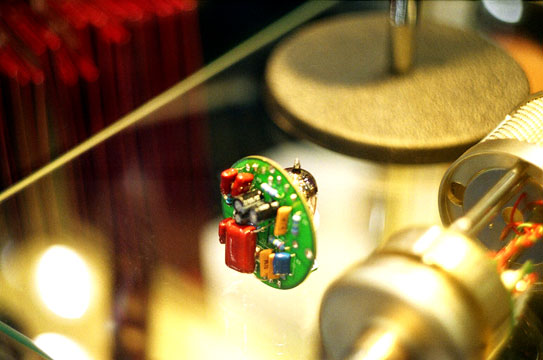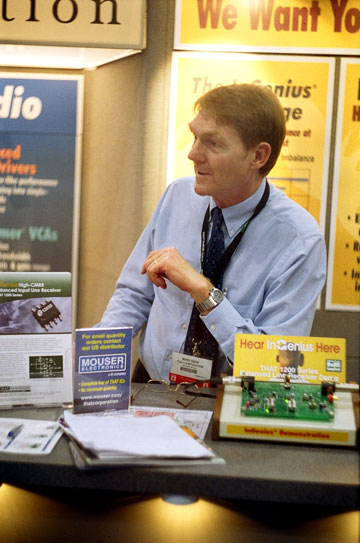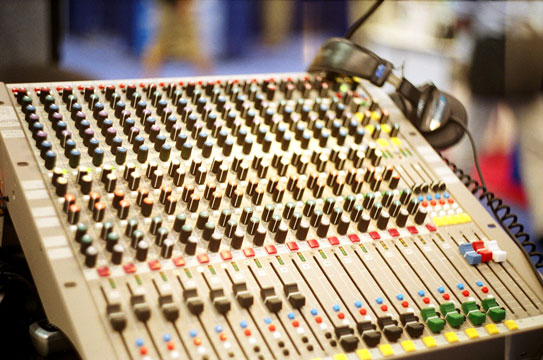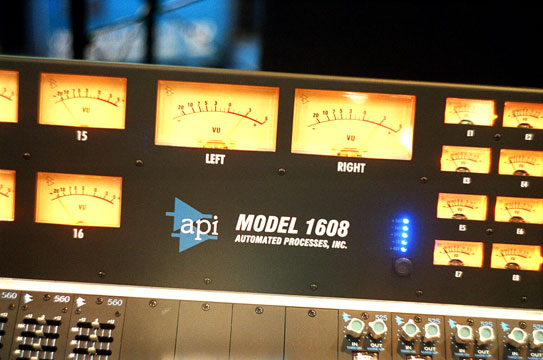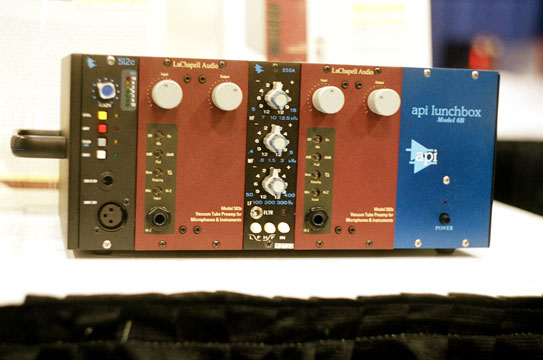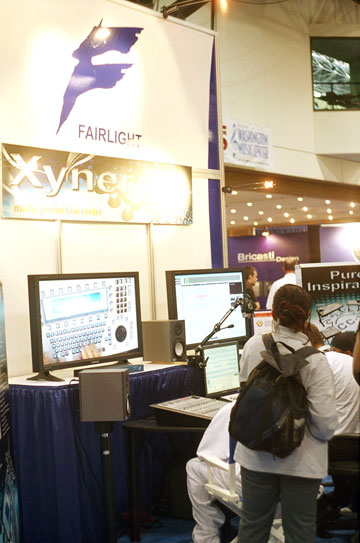|
You are reading the older HTML site
Positive Feedback
ISSUE
AES
2007: A Report on the Convention
I really enjoy attending the Audio Engineering Society conference every year and trying to write it up for a high-end audio audience, because it's such a different filter than most of the people at the conference are using. If anything, the AES show is actually two events, an academic conference and a vendor's exhibition, taking place in the same building at the same time. There's really surprisingly little mixing between those two sides of the wall. Another thing I try and do is to talk about the things happening on both sides of the wall, because they are both important. This year, I noticed that it's sort of a historic pattern that the things that most change the industry seem to come out at AES shows every ten years.
So, what in 2007 is appearing that is going to have a similar effect on the industry? I don't know. To be honest, I saw nothing this year that I found to be a revolutionary innovation, but then I didn't see those other items as being innovative when they came out either. I've never been good as a visionary, so my goal is to see and describe as much as possible in as short a time as possible. My apologies if I have missed something that you consider particularly important or dismissed lightly something you consider critical. This is more my brief whirlwind tour of a very large and extensive event than a detailed and careful inspection of every product and presentation. I've tried to select things that I personally found interesting, not using any more careful criterion than that. While attending the show, I was still recovering from the long drive up and an afternoon spent playing miniature golf with a friend's four-year-old, but here is what I saw: MICROPHONES
Telefunken USA sells reproductions of the classic old Telefunken studio condenser microphones, but they are now introducing the RM-5C, a microphone adapted for them from the RCA BK-5 design. I wasn't able to try it out, but the idea is an excellent one, with the BK-5 still remaining a very useful studio tool when a smooth top end and extreme directionality are required. Royer was showing their 122V vacuum tube active ribbon mike, which I recently reviewed in Recording magazine. Wes Dooley from AEA was introducing for the first time their active ribbon microphone, the AEA R440CX. This is based on the original RCA 44 design, but with an internal pre-preamplifier that allows the transformer to see a very high impedance, but allows the microphone to easily drive long cables with a low output impedance.
Skipper Wise of Blue Microphone Blue Microphone was showing their usual line of excellent studio microphones, but they are now also trying to push into the lower end of the market now that they are geared up for high production manufacture. Skipper Wise says that they have sold so many of their excellent studio mikes that the market is almost saturated. So, they are now making Joe, a project studio microphone intended for fairly neutral sound at $299, and Snowflake, a small USB mike they are intending to sell through retail discount outlets at $60. They also are now selling an active ribbon mike, just like Royer and AEA now are, called the Woodpecker.
Blue makes some fine microphones but owing to some accident in shipping had a corpse delivered to their booth instead of some of the items that they had sent from California.
Big microphone news this year was that David Bock, formerly of Soundeluxe, is now on his own and selling a line of nicely-built microphones under the name Bock Audio. This includes a mike based around the old Telefunken ELAM 251 design, as well as a tube and a FET-based condenser microphone of his own original design. Definitely worth looking at, and certainly a set of products with a future ahead of it. Kent Fuqua from KMF Audio was not showing any products at the show, but was wandering the halls talking about his new stereo tube condenser mikes. He was running an off-site demonstration that I was sadly unable to attend. The demo CD, though, sure sounded awfully bright and heavy in the presence region.
SE Electronics were showing some newer microphones from their factory in China, although the only one I got a chance to try out properly was their H1 handheld vocal microphone, intended for sound reinforcement. It was very, very bright with a very peaky top end, which is sound that seems very popular these days. Unfortunately the rear and side rejection didn't seem so great, but they should be given some credit as this is their first attempt at any sort of PA mike. Cascade was showing off a line of Chinese-made ribbon microphones, all of which seemed to have very strange and unusual sound characteristics. I'd definitely like to audition some of these because they have some sounds that could be useful, and are far from common. Another company, Violet Microphones from Latvia, was showing off a line of neat-looking studio and stage microphones. Sadly, their acoustical design did not seem to be up to the quality of their aesthetic design; the Ruby stage mike had a very peaked-up top end and huge amounts of midrange pickup from the sides and rear.
Sennheiser was showing their new MKH 8000-series condenser microphones, the latest in a line of products they have been making since the late 1960s. These are extremely low noise microphones that use a tuned oscillator and a discriminator to sense the changes in capsule capacitance rather than a fixed charge on the capsule; this results in fewer problems in high humidity environments like folk festivals. Positive Feedback Online's own Mike Pappas was on hand to show the new mikes off. Transamerica Audio is now importing the Sonodore microphones, which are high precision small diaphragm condenser types that appear to be derived from measurement microphone designs. Unfortunately they are sold out of them and didn't have any to see at the show, which was a shame since it's one of the products I really wanted to test out.
Josephson was showing the Josephson 606 microphone using a standard Type I measurement capsule, but allowing phantom power operation. Likewise, ACO was selling a similar device called the 7052PH which allows phantom use of the 200V measurement omnis. Microtech Gefell was originally a Neumann factory which was on the Eastern side of the wall when Germany was divided up after the war. Among other things, they continue making the old Neumann M7 capsule. This year they also showed some interesting new measurement products, including a microphone array for measuring sound power levels (photographed on their brochure measuring noise from a Trabant).
A new company from Germany called Horch was showing some large diaphragm tube condensers, but the demo unit I tried did not seem to be working properly. The LEDs inside the grille lighting them up seemed a bit silly, however. Lauten Audio was showing off the Horizon, a Chinese-made large diaphragm mike with a peaky top end, but what seemed to actually be a good pattern with excellent rejection from the rear. This is a good sign and definitely an improvement over the typical Chinese products. Last year, after decades of saying they'd never do it, Schoeps introduced a shotgun mike. So this year, DPA had to introduce one. The DPA mike was pretty directional even in the midrange; it appears to actually be a hypercardioid with a short interference tube added so the off-axis weirdness is reduced a lot over a traditional shotgun (much like the Schoeps). Worth checking out if you need directionality at all costs, because the actual sonic cost is a lot less than that of the alternatives. On a slightly different note, Latch Lake and K&M were both showing off lines of excellent stage and studio microphone stands, while Wes Dooley at AEA had some nicely-built tall stands for area mic'ing in large rooms. Microphone stands aren't exciting until they break—and then they are much too exciting—so I am in favor of more boring stands that don't break.
EveAnna Manley of Manley Laboratories, Inc. Downstairs in the paper sessions, Christhof Fuller from Illusonic in Switzerland was speaking on A Highly Directive 2-Capsule Based Microphone System. He used two opposite-facing cardioid capsules, then removed signal correlated between the two channels using a simple DSP transform. Unfortunately he presented no actual measurements of the combined system, so it's impossible to tell how it really performed. Real cardioid capsules are very different than idealized ones, and there was no error analysis presented either. Preprint 7313. Douglas McKinnie from MTSU talked on A System for Remote Control of the Height of Suspended Microphones, describing a system that he had built for permanently-installed microphones in Symphony Hall in Boston, which allows microphones to be rapidly deployed from storage positions in the ceiling. Unfortunately the system he constructed seems to have no real advantage over a commercial product currently available from Servoreeler. Preprint 7305. Nils Peters, Stephen McAdams, and Jonas Braasch gave a paper entitled Evaluating Off-Center Sound Degradation in Surround Loudspeaker Setups for Various Multichannel Microphone Techniques. Most listening tests of surround mic'ing systems involve high grade playback with the listener in the sweet spot. But what if the listener isn't in the sweet spot? How does that affect the perceived differences between mike techniques? What they sound that was interesting was that the variations depended more on the instruments and music recorded than the actual mic'ing technique! Preprint 7197. Another paper on multichannel mic'ing was Correspondence Relationship between Physical Factors and Psychological Impressions of Microphone Arrays for Orchestral Recording by Toru Kamekawa, Atsushi Marui, and Hideo Irimajiri. They recorded an orchestra with eight different common surround microphone configurations, and compared measurements of the arrays with perceived image data from a listening panel. Once again, they found that the correlation between measurements and listening depended radically on the original source and that different music created very different results. Preprint 7233.
SPEAKERS PAS was demoing their PI-12 coaxial PA speakers. Slightly spitty, but relatively clean and with good even dispersion even if a little bass-light for a 12" device (admittedly in a small box). RezCom Systems was showing off their Soundlab speakers, which are conventional boxes built with JanZen-like electrostatic plate tweeters. Designed by Dr. Roger West, I found the demo a little harsh sounding and kind of spitty, but given the driving sources it was hard to blame the speakers for that. Dennis Spurier is selling these under the name Quantumphonic Speakers. New to both the show and the US market was BMS, a German company making some very nice-sounding coaxial drivers. I got to audition their 6" driver, which sounded great and had much more low end extension than you would expect from such a small driver, especially in the small box they were using. A little harsh, but entirely respectable. Their 8" driver was demonstrated in an 8 litre box and was more extended on both top and bottom. They suggested using it with a subwoofer, but it might perform quite well just by itself in the right box if you don't need extremely high levels. I urge anyone interested in horn speakers for home use to investigate these drivers, as well as anyone building horn monitoring systems. Jack Arnott with Assistance Audio is their US distributor and seems very helpful. Faital Pro, an Italian company, was also new to the show this year and demonstrating a line of compression drivers and woofers based on high output neodymium magnets. Since these are pro audio drivers, the woofers are intended for high output, but none have an Fs lower than 31Hz. Still, sometimes efficiency trumps everything and these drivers are definitely efficient. Chris Pelonis, well-known as an acoustician for some very fine studio designs, was showing off a pair of speakers he is now manufacturing, based on the Tannoy dual concentric drivers but voiced very differently than the Tannoy products. Driving them from his own Pelonis Mosfet Amp, it was clean with detailed top end but without harshness or spittiness. They had a very nice and wide sweet spot, although the imaging was a little bizarre due to reflections in the booth area. I'd definitely like to hear these under better conditions.
Down in the paper sessions, Sigfried Linkwitz was presenting a paper called Room Reflections Misunderstood? in which he described the ambient room reflections in a listening room as aiding actual imaging, and showed some subjective tests and objective measurements comparing monopolar and dipole loudspeakers in a typical living room. The additional reflected sound from the room (provided by the rear lobe of the dipole speaker) arrives after the direct sound from the front lobe, so it provides a sense of space without the sound appearing to come from somewhere other than the location created by the sounds from the front lobes. Very interesting, and worth reading for anyone interesting in dipole loudspeakers. Preprint 7162. Bo Pederson and Finn Agerkvist from Denmark spoke on Time Varying Behaviour of the Loudspeaker Suspension. Everyone knows that loudspeaker suspensions aren't perfectly linear across their range, but these folks show that recent cone movement results in heating of the suspension which temporarily changes the behaviour of the suspension. An interesting effect, and they go well toward quantifying it. Preprint 7192. Delphine Bard from the University of Lund in Sweden took a different approach in Modelling of Nonlinearities in Electrodynamic Loudspeakers, though she was worried about voice-coil heating effects rather than specific suspension effects. She used a mathematical function called a Volterra kernel that allows you to create an effective model of a time-invariant system, but she did it for a given speaker a number of different times, at different voice coil temperatures, then build a simulation that used different modeling kernels at different temperatures. The overall behaviour seems to fit well with measurements. Preprint 7186. Most folks designing loudspeakers start out with a conventional one-dimensional transmission line model of the speaker (which is basically what the old Thiele-Small models do), build it, and then successively refine the design until it matches the model. Better modeling can help these problems, but full 3-D fluid dynamic models are difficult and slow. In Improvement of One-Dimensional Loudspeaker Models, Juha Backman from Nokia compares some simple models with full 3-D computational models, and provides some additional correction factors to help align the results of simple models with real world behaviour. Preprint 7253. In A New Methodology for the Acoustic Design of Compression Driver Phase Plugs with Concentrica Annular Channels, Mark Dodd and Jack Oclee-Brown look at the original work done by Bob Smith in 1953 on phase plugs for compression drivers, and note that this model makes the assumption of a flat diaphragm. They determine that if the assumption of a curved diaphragm is made, the optimal phase plug design is somewhat different, and that is an exciting finding that can lead to more linear compression drivers for horns. Preprint 7258. Francis Manzella, another well-known studio designer responsible for some excellent rooms, was showing off the Griffin loudspeakers which he is importing from Norway. In previous years they have shown larger designs, but this year they were demonstrating the G2A, a smaller mid-field powered speaker built with a D'Appolito configuration using a small Bohlender Graebner ribbon tweeter. They also had the next step up in the line, the G1 Studio, which uses a similar configuration with a Stage Accompany tweeter capable of higher levels and slightly different radiation pattern, along with a large woofer for better low end extension. Both of these sounded excellent in their well-treated demo room, certainly a change from the rest of the show. Next door to their demo room was the demo room for Equator Audio. These folks are selling a studio monitor speaker built into a cube, with a coaxial horn mounted in the middle of the woofer in a design very reminiscent of the old Altec 604. I was told that in fact the designer was an old Altec guy. The difference between this design and the Altec is that substantial amounts of DSP are being employed to deal with the cabinet standing wave issue and the horn and compression driver honk issues. The overall sound was really quite good... the top of the top end wasn't there, but the sound was smooth and not at all honky. Very wide vertical dispersion but narrow horizontal dispersion. There were some weird imaging issues but those were almost certainly due to the room. These things struck me as sounding much better than they have any right to sound, given the way they look. I went in expecting to hate them, but I came out really pleased with the sound. These guys, by the way, also have some automated room tuning stuff built into their DSP system, which brings us to... ROOM EQ Automatic room equalization. Press a button, the machine makes a measurement and equalizes everything. There's only one problem: it doesn't work because you can't fix impulse response issues with equalization. At best you can kind of hide some of them, but the computer doesn't know which ones or how. The sheer number of vendors selling systems this year was alarming. Everybody had it built into speakers. JBL had it. Genelec had it. The aforementioned Equator Audio Research had it. The most impressive of these demonstrations was from Real Sound Lab, a company in Latvia. Their system, called Coneq, uses a sample taken with a moving microphone to determine average sound power levels (not sound pressure) levels across the room. They average the hundreds of samples in some mysterious way and generate a 4096-point correction curve. The first demo was a before and after test with Tannoy 8" dual concentric monitors, and Genelec 1032 monitors, but what was interesting is that the sound was noticeably louder with the system turned on. I can't say it made things sound better, but it sure made them brighter. Then there was a test with an EAF-200 horn-loaded PA speaker, which did sound better, in part because the top end was so badly damaged by the speakers themselves. And equalization systems CAN fix those kinds of problems very well. THEN they did a demo with a jazz trio, switching between a recording and the live musicians every four bars. It was painfully obvious which was the recording and which was live; the fundamental on the string bass dropped out completely on the recording and the sax tone was sufficiently different that it seemed almost like two sax players playing a counterpoint with one another. Surprisingly, though, the piano seemed to pass through unscathed, and I would have expected it would be the most difficult of the three to reproduce properly. Anyway, bad demo, generally misguided product. IK Multimedia was selling a similar system which used a smaller number (only ten) point source sound pressure samples. They claimed, "All rooms distort sound, until now," and that their system "corrects for both time and frequency response problems," even though they admit it's a simple minimum phase equalizer. They claim, "Finally you can trust the sound of your studio," although I'm not sure I'd trust the sound of ANY studio, even one that has been properly treated. The marketing guys are working heavily here too. Down on the paper track, Jakob Dyreby and Sylvain Choisel gave a talk called Equalization of Loudspeaker Resonances using Second-Order Filters based on Spatially Distributed Impulse Response Measurements. Now, although you can't effectively deal with room resonances with EQ, it is possible to deal with many speaker resonances with EQ, because the change in response is the same throughout the room. However, using conventional minimum phase filters just turns one kind of response problem into a different kind of response problem. These folks show a filter design that seems to work effectively for one class of problem, and that's more than most folks can say. Preprint 7205. Another reasonable application for this sort of device is in typical "multimedia" systems where both the speakers and the local environment have such catastrophic response problems that the use of equalization merely to hide the worst of the problems can be a great improvement, crude though it is. James Johnson and Serge Smirnoff from Microsoft talked about the room correcting system built into Microsoft Vista, in A Low Complexity Perceptually Tuned Room Correction System. What is interesting is that they talk about the problems the system tries to compensate for, like broad peaks and channel imbalances, and problems the system specifically avoids touching, like low frequency suck-out issues. Although the system itself is a black box that won't give you any information about what it's doing when you use it, the paper gives some real insight into what went on in the design of the system and what the system actually does. Preprint 7263. John Vanderkooy from the University of Waterloo spoke on Multi-Source Room Equalization: Reducing Room Resonances in which multiple loudspeakers in a room were used differently. Looking at the low frequency energy in the room, some of the speakers were used to provide out-of-phase bass information in order to move the various peaks and dips around in the room and change the distribution of them. Dr. Vanderkooy states "Results are encouraging but not striking," which is pretty good considering the complexity of an untuned listening room. Preprint 7262. HEADPHONES The most exciting and terrifying thing on the headphone front is that Adriano Farina from the Liceo Ginnasio in Italy talked on A Study of hearing Damage Caused by Personal MP3 Player. The study was kind of misnamed, since it didn't measure the damage so much as the potential for damage. They looked at the level various Italian high school students were listening to music at, using a dummy head assembly to measure actual sound pressure levels at the ears, and the numbers they were seeing were all pretty horrifying and well above the levels expected to cause permanent hearing damage. I think we all know this is a problem, and I think we have all observed hearing loss among teenagers these days, but this is a study actually quantifying it. Preprint 7283. John Diles from Livewires was doing ear molds for custom in-ear monitors and in-ear headphones. We ordered a set for my wife and she'll see how they sound. In Electret Receiver for In-Ear Earphone, Shu-Ru Lin from the Industrial Technology Research Institute in Taiwan was talking about the design of in-ear speakers using electrostatic transducers, much like a miniature Stax earspeaker. Frequency response was sacrificed for the ability to drive it from low voltages, and insufficient time was spent modeling the air flow through the body and ear tube, but it was certainly a step in the right direction toward miniaturized electrostatic headphones. Preprint 7284. Michael Lester and Jon Boley from Shure were talking The Effects of Latency on Live Sound Monitoring. There have been a lot of debates in both the recording and PA community about how much delay is acceptable on monitoring feeds; in the new digital era it's not unusual for delay to become a real problem, but nobody really knows how much is too much. Lester and Boley find that the amount perceived to be a problem varies very widely the instrument, much more than the differences between individual listeners. And the differences are wild, with some situations having 42ms considered acceptable while other situations had difficulty with 1.4ms. Preprint 7198. And finally, Arnaut Nagle and some friends from France Telecom were talking about the Quality Impact of Diotic Versus Monaural Hearing on Processed Speech. They had a listening panel listen to sample speech processed by various VoIP encoding methods and found that intelligibility was better when both ears were used instead of just one. But what was interesting is that when folks were asked to rank the audio quality of the various codecs, the rankings were quite different for the one-ear group versus the two-ear group. The authors give a few proposed explanations for the effect. Preprint 7220. ACOUSTICAL STUFF
Niels Werner Larsen from Flex Acoustics in Denmark was talking about a flexible bass absorbing device. A lot of folks want to use the same concert hall for classical music where long reverb times are needed, but then they also want to use it for rock music where a short reverb time is needed. You can throw up curtains to damp down the high end, but there is not much to be done about the low end. Mr. Larsen, along with Eric Thompson and Anders Gade from the Technical University of Denmark, has devised an inflatable rubber bladder device which can be unrolled on the walls and pumped up to set the low frequency room RT60 to whatever value is desired. Preprint 7190. Incidentally Mr. Larsen also presented another paper in which he gave actual measurements of concert halls and correlated RT60 and room volume with perceived subjective sound quality for rock music. This is interesting since I think it's one of the first studies of this sort, which attempts to determine what the actual desirable characteristics of a room used for rock concerts really are. Acoustics in Rock and Pop Music Halls looks like something Sabine would do if he were still alive today. Preprint 7246. Patty Huang and Johnathan Abel from the CCRMA at Stanford were speaking on Aspects of Reverberation Echo Density. Everybody knows the difference between a good-sounding hall and a bad-sounding hall, and that the slow and smooth decay of reverberation is critical to what makes a good hall. These folks compared measured impulse responses with perceived hall evaluations, to determine what really does matter, and so that in the future we can correlate audible effects with measured or estimated responses. Preprint 7163. Jamie Angus from the University of Salford in the UK was talking about Diffusers with Extended Frequency Range. He proposes a power residue formula for setting up diffusers with slightly more low frequency effectiveness than similar sized quadratic residue diffusers. Interesting poster presentation and the paper is worth reading if only for the background material on older designs. Preprint 7193. Sean Olive from Harman International and William Martens from McGill University did some experiments in Interaction between Loudspeakers and Room Acoustics Influences Loudspeaker Preferences in Multichannel Audio Reproduction. They used a multi-driver speaker which could be easily configured into several different kinds of speaker on the fly by enabling and disabling various redundant drivers. Some of the things they found are things you'd expect: for example, the reflectance of the room affects listeners' preference in speaker, and so does the program material. But they also found that adoption to a different room acoustic was very rapid, and that the experience of the listener dramatically affects configuration preference. Interesting if you are at all curious about speaker testing, even if much of it may seem like common sense on the face of it; common sense often turns out to be wrong, so it's good to see measurements like these made. Preprint 7196. Zhixin Chen and Robert Maher from Montana State talked on Addressing the Discrepancy Between Measured and Modeled Impulse Responses for Small Rooms. They pointed out that when impulse responses are typically measured they are done with microphones that are not truly omni-directional, and speakers that are far from actually omni-directional. Because of this, ray-traced simulations of the room results in differences from the measured response. Although we can't buy a perfect speaker, we can simulate the speaker and microphone aberrations in the ray-traced simulation. They find that if this is done, the simulation matches up much better with actual measurements. Preprint 7239. Eric Blackmer, formerly of Earthworks, is now out on his own doing studio and acoustical design work on contract as Blackmer Sound. He's a good guy who knows what a good room should sound like and might be a person to contact if you're looking to build a purpose-built listening room. Bag End Loudspeakers is now selling a device called the E-Trap, which is an electronic bass trap. You set it to two broad frequencies, and it acts as a tuned bass trap on those frequencies, but is far more effective than a passive trap of the same size. Good when dealing with small rooms with standing wave problems that there's no space to solve the conventional way, and definitely worth looking into for small listening room situations. IAC was showing off sound control doors and other sound isolation products. These are very common in studio installations, and I'd like to see them more in home installations to keep sound where it belongs. Folks have been using perforated desks to reduce reflection problems with round table discussions and announcers for fifty years now; Nesbitt mentions it in Techniques of the Sound Studio as a standard BBC technique. But Karl Genter, Jonas Brasch and Paul Calamia did a systematic study on the use of perforated desks, and what patterns and hole layouts gave best results. Another simple idea, but well-elaborated and carefully systematized. Preprint 7199. MEDIA
Mike Spitz and Fred Schuckert's company ATR Magnetics has been at the show for several years talking about their intention to produce magnetic tape, but this was the first year that they actually did produce tape for sale. They had it on display, as well as some of the ATR Service Company's tape machine retrofits.
RMGI has been selling some excellent analogue mastering tape starting with the show last year, and they are now also importing the Green Tune CD-R discs made by Mitsubishi. These discs are optimized for slow speed recording, low error rates, and (hopefully) long storage life. CABLES AND CONNECTORS The usual cable vendors were at the show, guys like Switchcraft and Neutrik that everybody knows and which make good solid reliable connectors that everyone either uses, or wished they had used. Don Grossinger from BTX was showing off their line of quality cables and assemblies as well. But in the new and interesting category was Har-Ken Specialties, a company making a line of unusual adaptors and connectors, including XLR connectors and 1/4" phone connectors to binding posts and RJ-11s, attenuators that operated in small steps, and other extremely useful tools to have around—ones that people don't seem to think much about until they suddenly realize they need them. Definitely it's worth looking at these folks' web site, because they have a lot of neat problem solving adaptors, all basically handmade, and sooner or later you'll find you need one for something. All the usual cable vendors were there as well, from Gotham Cable and Mogami to Gepco and our friend Steve Lampen with Belden. But this is the first year any of the audiophile power cable guys have shown up. While longtime readers will remember my skepticism about the whole audiophile power cable thing, Essential Sound's Essence cable has been reviewed well by others in Positive Feedback Online. Essential is now making the Audio-Video Professional series cable which they are selling into the pro audio market; it's a similar configuration but with stranded cable for ruggedness, and a UL listing. It's probably the only one of the audiophile power cables with an actual UL listing. Whether or not you believe anything about the sonic benefits, the cable seems well made and the rugged design of the hospital grade connectors probably makes it worthwhile just for improved reliability compared with cheaper cables. Michael Griffin from ESP was very enthused about the new pro audio market for them. USB INTERFACES Everybody wants to plug their microphone into a USB port today. That's why Blue is making that USB-based microphone. Seems like everyone else is doing it this year too, including dozens of the Chinese resellers from SE Electronics to Marshall. There are also a bunch of people now selling standalone interfaces that plug into a microphone. The problem is that the USB interface does not supply a lot of power; hardly enough to provide 48V phantom, let alone drive electronics as well. Dan Lavry of Lavry Electronics sells a device, and he gets around the problem by not offering phantom power. Many other vendors either violate the phantom power standard and provide less current than they should, or they violate the USB spec and require more current than they should. Centrance is now selling the MicPort Pro, a small cylinder that plugs into a microphone and provides a preamp, phantom supply, and USB interface. Marshall Electronics sells the MXL MicMate which does the same thing. How do these get around the phantom power issues? The vendors wouldn't tell me, so you'll have to find out for yourself. PARTS
There are always a couple transformer vendors at the show, starting out with Lundahl, which makes some of the finest audio transformers around both for line-level signals and output transformers for tube amplifiers. Among other things, they were showing off an excellent moving coil step-up transformer which was recently reviewed very favorably in Stereophile. This year Triad was introducing a very inexpensive 1:1 1000 ohm line level transformer, specified at 1 dB from 10C to 20KC with proper loading, which will sell for under two dollars. That's a big deal, in spite of the load sensitivity, since it may allow some products to use input transformers for better isolation at a price point that otherwise would have been impossible. Jim Mettler was very proud of the thing, and I'm looking forward to trying it.
Marv Hahn of THAT Corporation Texas Instruments/Burr-Brown and THAT were both showing off high grade preamplifier, line driver, and balanced receiver chips. But what was really interesting was a simple op amp, the LME49860 from National Semiconductor. Very low noise, very low distortion, very nice looking Bode plot. It'll only handle 22V rails, but it'll swing within a volt and a half of each rail into a 600 ohm load which eliminates the need for additional drive transistors off-chip. Definitely worth looking at for the next super-clean op-amp design, and I enjoyed talking to Bill McCulley about it. Wolfson Microelectronics was showing a high end 24-bit 192ksample/sec DAC with an additional input for a DSD datastream for SACD decoding. This is a rather sophisticated design with thought employed in reducing out of band noise and pre-ringing on the filters. Look for it to be showing up in commercial standalone DAC units soon. Paul Snow from Bourns was showing their line of potentiometers, including a couple very nice feeling new types they are pitching to the guitar market, which needs very high values. Michael Williams and Richard Vanderslice from Sellmark were showing their line of switches, potentiometers, and reverb units which they are importing from Korea. SIGNAL PROCESSING The most exciting thing in the signal processing range was that Burgess Macneil from Sontec is back in business supporting the older Sontec and ITI equalizers. On top of that, he is making some new products, including the Duo, an equalizer that combines the new super-clean Sontec electronics with the older and more slew-limited ITI electronics, and with switches to change from one configuration to the other. It is absolutely wonderful to see Burgess at a show again and to see new products coming from his shop. Blue Coconut Unity from the UK was showing off their Echoverb, a six-head tape loop echo system. Beautifully machined, it was like the old Echoplex, but much nicer. Definitely a production tool that will give an effect you really can't get any other way. Joe Malone from JLM Audio in Australia was showing some wonderful looking little preamplifier and equalizer modules that slipped into the API racks. They had some hand-built prototypes, but no marketing literature at all so I can't say much about them except that they are definitely worth looking out for. They have a PEQ500 passive equalizer, a TG500 preamp, and an MPM500 baby mixer module. There were a lot of signal processing papers, and I didn't get a chance to see more than a couple. E.V. Harinarayanan and some other folks from ATC Labs were speaking on A Novel Automatic Noise Removal technique for Audio and Speech Signals, in which they describe trying to extract audible speech from very noisy signals using adaptive filters that are dependant on speech characteristics. Preprint 7170. Remember the days when mono recordings were "electronically reprocessed for stereo sound"? Folks want to do that sort of thing to turn stereo recordings into surround recordings, but this time they actually want them to sound good. This involves determining what part of the recording is ambience and what part isn't. The old Hafler Connection would direct the difference between the two channels to the rear speakers, so everything common to the stereo channels would stay out of the surround. A much more skillful method of doing this was detailed by Juha Merimaa et al. in Correlation-Based Ambience Extraction from Stereo Recordings, in which they use statistical correlation measures to derive an ambient surround signal. Preprint 7282. In An In-Flight Low Latency Acoustic Feedback Cancellation Algorithm, Nermin Osmanovic, Victor Clarke, and Erich Velandia design a DSP system to process aircraft cockpit microphone signals to prevent feedback from the cockpit communications audio system. What makes it interesting is the way they determine when and where feedback occurs, so they can drop a notch filter there. Not really applicable to high end audio, but it was an interesting discussion that I enjoyed. Preprint 7266. Everybody knows that the THD and IMD measurements used to correlate well with perceived distortion, sixty years ago, but that with modern systems they no longer do. But how do we measure distortion in a way that actually tells us something useful about a piece of equipment? In Measurements and Perception of Nonlinear Distortion - Comparing Numbers and Sound Quality, Alex Voishvillo from JBL provides a good overview on what is known today about the audibility of different kinds of distortion, and how they measure them in isolation. There's nothing unique in this presentation, but it's a great view of a lot of different research all in one place, and I urge you to get the preprint if you are at all curious about distortion measurements. Preprint 7174. MIXERS
Lots of mixers at the show, including designs like the Speck LiLo that I have talked about before, and the APB Dynasonics, which is one of the more solid small format consoles out there.
But there are some new ones that haven't been seen before. API is making a small modular console called the API 1608, very solidly built with traditional electronics design, and a 16-channel version is available for under $6K. That's a big deal, and Mark Seman was very happy to show the ins and outs of the design. Rupert Neve Designs was selling their 5088 small analogue mixer, with different layout but a similar overall feel to it, demonstrated by Josh Thomas. And then there were some little things, like Inward Connections' little Mix 690 16-channel mixer that fits into a 2U rack space.
In the paper sessions, Joern Loviscach from the Hochschule Bremen gave a presentation called Music at your Fingertips: The Electrotactile Fader. This was a mixing console fader with an electrode array mounted on it that applied short low-current pulses to the skin to allow the user to feel different patterns. It can create a sensation that feels like a number or to "display" the signal level on a channel, to help aid eyes-free mixing. Preprint 7306. CONVERTERS Eelco Grimm of Grimm Audio has been making an excellent all-discrete A/D converter for DSD recording, one of the finest around. He still hasn't produced a PCM backend for the thing, however, which is bad since I think it was (aside from one Korg recorder) the only piece of DSD equipment at the show. However, he applied similar quality design to the CC1 master clock, which provides central clocking with a stable and jitter-free clock to everything in the studio. That's a big deal. Burl Audio is now making an A/D converter with transformer isolation on the inputs, mixing fairly traditional pro-audio designs with traditional noise reduction techniques and discrete analogue electronics with a modern A/D front end and AES/EBU outputs. Definitely an interesting mix of technologies, and different than anything else out on the market. Stephan Flock from RME was showing off a very nice line of converters and interface devices which I've mentioned in previous years. Well-designed and solidly built. Ramdas Kumaresan and Nitesh Panchal from the University of Rhode Island gave a poster presentation called Encoding Bandpass Signals Using Level Crossings: A Model-Based Approach. This shows a new way of encoding a signal as a set of discrete time/frequency values. It's different than PCM, and different than DSD. Is it useful? Who knows, but it's another interesting encoding approach that at the very least is an interesting mathematical curiosity and may someday have applications. Preprint 7290. WIRELESS MIKES Because of the change in the TV bands with the coming of HDTV, wireless microphones, which are most commonly used on open television channels, are going to start having big trouble. There were a number of discussions and tutorials about the impending disaster. A number of vendors, including MiPro and Sony were coming out with spread spectrum digital wireless systems. Sony's DWT-B01 digital wireless system and Mipro's ACT-81 encrypted digital wireless systems are definitely among the many attempts to deal with the crisis before it hits and existing narrowband analogue wireless systems become unusable.
OTHER THINGS A company called E-Session makes a collaborative tool that allows people to work together from disparate locations using the internet. I don't know much about it except that you could get your picture taken with a girl in a French maid's outfit at their booth. A company called A-Volute was selling a "3D Sound Expert" called Nahimic which they claim to produce surround sound and other fancy immersive imaging through a single pair of low-cost speakers. Their demo was not impressive. The Electronics and Telecommunication Research Institute from Korea was showing off their new object-based audio technology, which they claim will revitalize the sluggish record market, allow listeners to alter music to their taste, and in general allow end users far too much control to damage sound quality. SPLNet Systems was selling a nifty little sound level meter that was remotely readable through SNMP. You plug a microphone into it, plug it into your Ethernet, and it uses standard Power Over Ethernet and provides an SNMP source that can be read by a variety of standard software, including most network monitoring tools. Excellent if you have an existing Ethernet infrastructure and want to know about noise levels, as you would expect in a lot of auditoria today. Gordon Kapes is the guy to talk to. The House Ear Institute was doing hearing testing again this year, and they had a database of previous years' data from shows so people who had been tested previously could see trends. I was surprised to see my hearing tested better this year than in previous years, and when I mentioned this to David Josephson, maker of excellent microphones, he suggested it might be because I had my hearing tested earlier in the show than in previous years. Sadly, I can believe that would make a difference, and I normally wear earplugs for most of the show. Oh yes, and Nagra was showing off their Nagra VI six-channel digital location recorder. Sounded nice, looked nice, and it appeared to be rugged enough to actually carry on the Nagra field recorder tradition. Incidentally one of the most exciting new things coming out at the show is the AS-X064 test disc. This is a re-release of the old IEC Pub 98 wide-groove test disc, for 78 rpm playback. After many years of it being out of print, it is very nice to have a test disc available for proper setup of 78 playback systems. The disc is available through the AES website and everybody who deals with 78s really needs one. I went to the meeting of the standards committee that issued it, just to thank them. Also we discovered the Sanur Restaurant, with what I'd call Straits Chinese food, at 18 Doyers St. NY. All the traditional Indonesian and Malaysian food, and Chinese food done in the Malay style. We ate there with Lofty from Audix and you should eat there too. It's not far away from the Original Chinatown Ice Cream Factory either, with their excellent litchi and ginger ice creams. We also ate at ABC Chinese Restaurant, formerly Danny Ng Restaurant, formerly Lucky Garden Restaurant, and to be honest I don't think it was as good as it was before, even though most of the staff are unchanged. Down in the paper sessions, Catalin Grigoras, a forensic examiner from Romania, spoke on the subject Applications of ENF Analysis Method in Forensic Authentication fo Digital Audio and Video Recordings. He stated that since modern digital recorders have extremely good clock stability, and since the power line frequency wanders slightly (and due to the national grid it remains the same across a huge area), that if we have a hum on a recording we can extract a map of the frequency variations and compare them with recorded line frequency variations. This allows us to verify when a recording was made, and to some extent what area it was made in (i.e., which electrical grid). I just think this is the most ingenious idea since it seems so simple and obvious once it's explained, but the technique is so powerful. Preprint 7273. Later on, Eddy Brixen from Denmark spoke on Further Investigations into the ENF Criterion for Forensic Authentication in which he detailed additional measurement systems, how to easily acquire reference databases, and showed examples of hum through popular low bit-rate codecs that even preserved frequency information surprisingly well. Preprint 7275. Everybody knows that when you can't make out distorted speech, turning the level up will help intelligibility. Or maybe not. Nicolas Cote, Valerie Gauthier-Turbin, and Sebastian Moeller put it to the test in Influence of Loudness Level on the Overall Quality of Transmitted Speech. They use lossy encoding systems and create varying amounts of dropouts, then test intelligibility. They find the optimal level depends on the encoding scheme; with some the intelligibility drops off with increasing level until a point where it picks up again. Preprint 7175. In Multiple Regression modeling of the Emotional Content of Film and Music, Rob Parke, Elaine Chew, and Chris Kyriakakis from USC attempt to model the effect of music on emotional content of film by presenting viewers with scenes with and without the music, and with the music alone, to see how they interact. The effect seems obvious on the face of it, and opera composers knew it centuries ago, but it's interesting that someone has decided to measure it. Preprint 7173. Another unusual sort of presentation was Piotr Odya and Andrej Czyzewski's Special Hearing Aid for Stuttering People, which also won the first prize in the graduate student category in the student design competition. This is a tiny hearing aid-like device with a small DSP processor built into it, which can be programmed to delay or pitch-shift speech to aid stutterers. What was fascinating was the hand construction of the device, which was all point to point wired in a couple cubic centimeters, and the careful programming required to use a comparatively low-powered DSP unit to accomplish the tasks. Preprint 7293. Also, of course, there were a lot of magazine vendors at the show, everyone from Sound and Communications and Music Connection, to Mix and Recording magazines, to Europeans like Audio/Media, Resolution, AudioPro, and Sound on Sound. Professional Sound from Canada was there, as was Songwriter magazine, and the film magazines like Post, Millimeter, Videography, and Editor's Guild. Specialty audio magazines like Multimedia Manufacturer, Voice Coil, and event-driven magazines like RentalStaging and the Event Production Directory were there. It's always enjoyable to see the show, and see what is new and what is not. To be honest, I think I saw both fewer really impressive things and fewer horrifying things than I have most other years. And you know, I am always happy to get home and listen to my Magnepans; everything else seems kind of silly in comparison, especially with a nice cup of tea. Why can't I get a decent cup of tea at the show? Perhaps that question will be answered next year....
|

